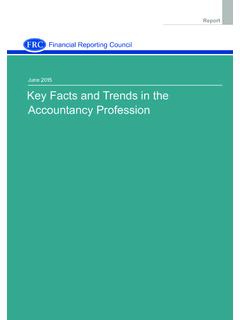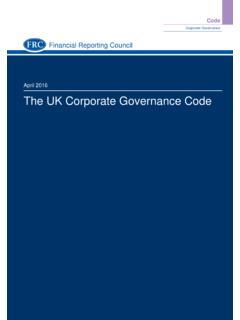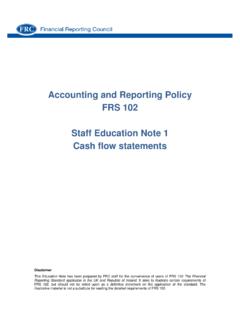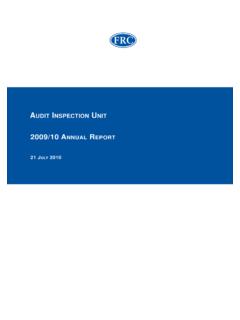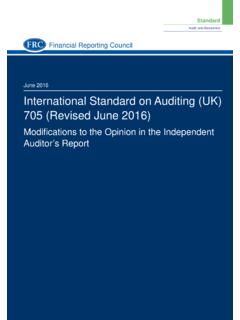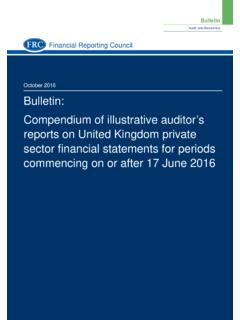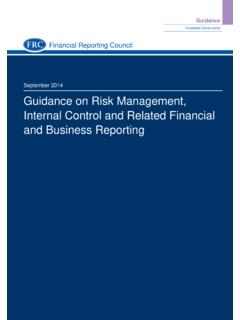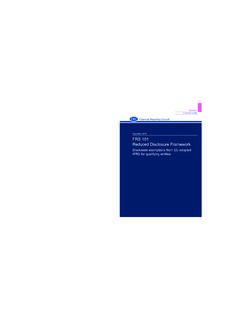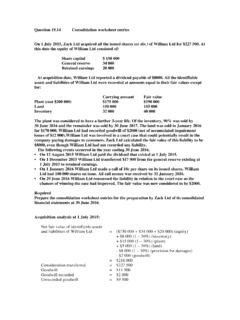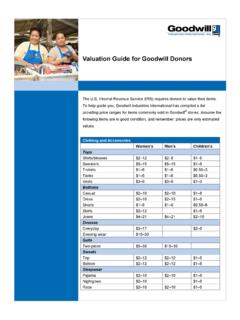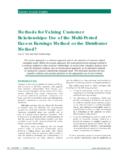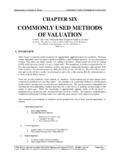Transcription of FRS 102 FACTSHEET 6 BUSINESS COMBINATIONS
1 FRS 102 FACTSHEET 6 1 December 2018 BUSINESS COMBINATIONS A BUSINESS combination is defined as the bringing together of separate entities or businesses into one reporting entity and may be structured in a number of ways for legal, taxation or other reasons. It may involve the purchase by an entity of the equity of another entity, the purchase of all the net assets of another entity, the assumption of the net liabilities of another entity, or the purchase of some of the net assets of another entity that together form one or more businesses. Section 19 BUSINESS COMBINATIONS and goodwill sets out the requirements for BUSINESS COMBINATIONS . This section also includes the requirements for group reconstructions, however, this is not covered in this FACTSHEET . This FACTSHEET has been prepared to provide a high level overview to entities applying FRS 102 that undertake a BUSINESS combination for the first time covering the following: An outline of the purchase method The separation of intangible assets from goodwill Illustrative disclosures This FACTSHEET has been prepared by FRC staff and provides high level guidance to entities applying FRS 102 that undertake a BUSINESS combination for the first time.
2 It should not be relied upon as a definitive statement on the application of the standard nor is it a substitute for reading the detailed requirements of FRS 102. FRS 102 FACTSHEET 6 BUSINESS COMBINATIONS FRS 102 FACTSHEET 6 2 December 2018 The Purchase Method The purchase method is the required accounting treatment for the vast majority of BUSINESS combinations1 and involves the following steps: 1) Identify an acquirer This is the entity which obtains control of other combining entities or businesses. 2) Determine the acquisition date This is the date that control is obtained, and the date from which the purchase method is applied. 3) Measure the cost of the BUSINESS combination This is the total fair value of any consideration given in exchange for control, plus any costs of acquisition. The consideration may include any combination of cash, cash equivalents, other assets, liabilities incurred or the issue of equity instruments.
3 4) Allocate at the acquisition date, the cost of the BUSINESS combination to the assets acquired and liabilities assumed, and recognise and measure any non-controlling (minority) interest An acquirer must identify and determine the fair value of the assets, liabilities and contingent liabilities of the acquiree at the acquisition date. Any difference between this and the cost of the BUSINESS combination (determined in step 3) is dealt with in step 5 below. The non-controlling (minority) interest is recognised at the date of acquisition and is measured at its share of the net amount of the identifiable assets, liabilities and provisions for contingent liabilities of the acquiree identified and measured as described above. This interest will change over time as the acquiree s net assets (as stated in the consolidated financial statements) change.
4 5) Recognition and measurement of goodwill goodwill arises when the cost of the combination exceeds the fair value of the identified net assets acquired; for example, if CU100m is paid for CU75m of net assets, then goodwill of CU25m arises. Negative goodwill arises if the cost is less than the fair value of the net assets acquired. Both goodwill and negative goodwill2 are recognised on the statement of financial position as assets. goodwill is amortised over its finite useful life and impaired if necessary. In the vast majority of cases, we expect entities to be able to estimate a reliable useful life for goodwill . Provided the entity is able to support its choice of useful life, there is no upper limit in this situation. However, in exceptional circumstances, if an entity is unable to do this, the standard does impose an upper limit of 10 years.
5 It is not a default position and a shorter useful life may be used. Because goodwill is amortised, it is only subject to an impairment review when there is an indicator of impairment. The recoverable amount of goodwill cannot be measured directly, because it cannot be sold by itself and does not generate cash flows independently. Therefore, its recoverable amount must be derived from measurement of the recoverable amount of the cash-generating units (CGU) of which it is part. If an impairment loss is to be recognised against a CGU, that loss is first allocated to reduce the carrying amount of goodwill allocated to that CGU, before being allocated to the other assets of the CGU on a pro rata basis. Key FRS 102 references , to to to to , Section 27 1 In certain circumstances merger accounting may be used such as for group reconstructions and public benefit entity COMBINATIONS that are a merger.
6 Certain conditions need to be met before this is permitted (see paragraph to and Section 34 of FRS 102). This FACTSHEET does not cover merger accounting. 2 Paragraph sets out the subsequent measurement requirements for negative goodwill . FRS 102 FACTSHEET 6 3 December 2018 Intangible assets acquired in a BUSINESS combination Step 3 of the purchase method requires an entity to identify and determine the fair value of an acquiree s assets, liabilities and contingent liabilities. An acquiree may have both intangible and tangible assets. The Triennial Review 2017 Amendments introduced a change in the requirements to separate intangible assets acquired in a BUSINESS combination . Mandatory separation Intangible assets acquired in a BUSINESS combination must be recognised separately from goodwill when all three of the following conditions are met: (a) the recognition criteria are met (ie that it is probable that economic benefits will flow and the value of the asset can be measured reliably); (b) the intangible asset arises from contractual or other legal rights; and (c) the intangible asset is separable.
7 We would normally expect licences, copyrights, trademarks, internet domain names, patented technology and legally protected trade secrets to meet all three criteria. We would not normally expect customer lists, customer relationships and unprotected trade secrets to meet all three criteria as no contractual or legal right exists that would give rise to expected future economic benefits. Optional additional separation FRS 102 allows entities the option to additionally recognise, separately from goodwill , intangible assets that meet the recognition criteria ((a) above) and only one of the other two conditions (ie either (b) or (c)). When this policy option is taken, it must be applied consistently to all intangible assets in that class across all BUSINESS COMBINATIONS . Transitional exception The Triennial Review 2017 Amendments include a transitional exception where the above requirements should only be applied prospectively ( only for those BUSINESS COMBINATIONS occurring in the first reporting period in which the amendments are applied or subsequently).
8 Therefore, any intangible assets recognised separately from goodwill in earlier BUSINESS COMBINATIONS are not now subsumed into goodwill . Key FRS 102 references Basis for Conclusions (b) FRS 102 FACTSHEET 6 4 December 2018 Illustrative disclosures BUSINESS COMBINATIONS can be complex and it is important that entities provide clear disclosures to ensure users can understand them. FRS 102 includes a number of disclosure requirements across three sections of the standard which cover general information on subsidiaries (and special purpose entities) that are both included and excluded from consolidation and detailed information about amounts included in the consolidation. Additionally, the Regulations also require the following disclosures: Certain information about subsidiaries including their name, location, shareholding and type of share as well as whether they are included or not in the consolidation.
9 In the year of acquisition (where the acquisition significantly affects the figures shown in the group accounts), whether acquisition or merger accounting has been applied and a tabular disclosure of the carrying and fair values of each class of assets (including goodwill and negative goodwill ) and liabilities with an explanation for any significant adjustments. The illustrative disclosures that follow, focus on the requirements in Sections 18 Intangible Assets other than goodwill and Section 19 BUSINESS COMBINATIONS and goodwill , and the Regulations noted above. Illustrative example Entity Z has a year end of 31 December and acquires 100% of the ordinary shares in Entity A Ltd on 1 April 2017 for in cash and ordinary shares. This is the first acquisition it has undertaken; the primary reason for this strategic move is to expand its geographical presence.
10 The fair value of Entity A s net assets at the date of acquisition is As part of the acquisition, Entity Z acquires Entity A Ltd s brand which has been valued at and believes that the brand will generate benefits for the combined BUSINESS for the next 12 years and have no immediate plans to change the name of Entity A. Management estimate the useful life for the goodwill to be 8 years. Entity Z Group Consolidated Financial Statements Notes to the financial statements Accounting policies Basis of consolidation The Group financial statements consolidate the financial statements of the Company and its subsidiary undertakings drawn up to 31 December each year. The results of subsidiaries acquired or sold are consolidated for the periods from or to the date on which control passed. BUSINESS COMBINATIONS are accounted for under the purchase method.
